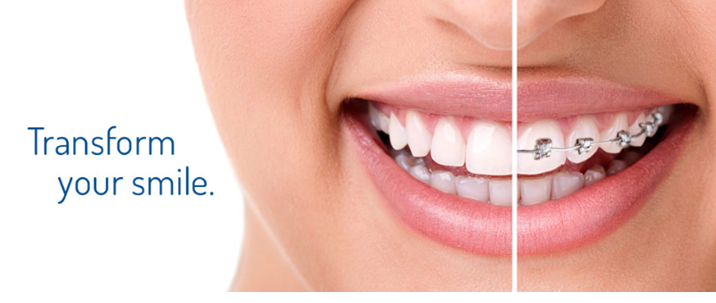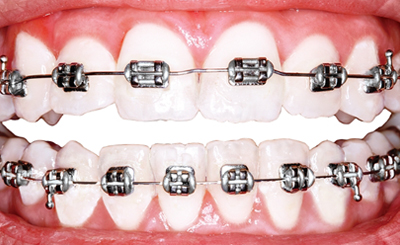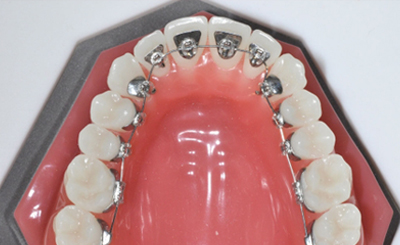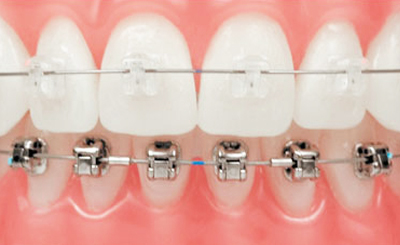Orthodontic treatment is a way of straightening or moving teeth, to improve the appearance of the teeth and how they work. It can also help to look after the long-term health of your teeth, gums and jaw joints, by spreading the biting pressure over all your teeth.
Orthodontics is a specialty discipline of dentistry that focuses on alignment of the teeth and jaws to improve a person’s smile and oral health. Orthodontists will diagnose, treat and prevent irregularities of the teeth with the use of braces, which are fixed dental appliances, and removable dental appliances, when the braces are removed. These devices can be used to straighten teeth, correct an irregular bite, close unsightly gaps and bring teeth and lips into proper alignment. Crooked teeth that do not fit together correctly are harder to keep clean and are at risk of being lost early because of tooth decay or periodontal disease.

What is a removable brace?
Simple treatment may be carried out with a removable brace (a plate that can be taken out to be cleaned). It has delicate wires and springs attached, which move the teeth using gentle pressure.
What is a fixed brace?
Often, teeth need to be guided more accurately than they can be using a removable brace. So a fixed brace is used. This has brackets and bands which are temporarily stuck to the teeth. A flexible wire joins all the brackets and allows the teeth to be moved. You can’t take the appliance out yourself, so it is called a fixed appliance.
What is a functional brace?
It is sometimes possible to change the way the jaws grow, using a functional brace. This works by using the power of your jaw muscles and can help with certain types of problem.
Types of Braces?
Metal Braces

Often also called “traditional braces,” metal braces have two basic components. These are the metal bracket that is applied to the teeth and the bendable metal wire that is threaded through the brackets in order to apply pressure to the teeth and ultimately move them. This is the type of braces that most teenagers get, because they are the least expensive version and are often the fastest way of moving teeth into their ideal locations.
In the past, the brackets and wires used for metal braces were very noticeable and could be annoying to those who wore them because of their size and intrusiveness. Today’s metal braces are far smaller and less noticeable than they were in the past. New technology has also created wires that move teeth faster and with less pain than in years past. Many teenagers also like the ability to choose the color of the rubber bands around each bracket, as this gives each person an opportunity to personalize their braces.
Ceramic Braces

Ceramic braces were once a very popular alternative to metal braces. Because the brackets were made out of a ceramic material that is the same color and has the same texture as teeth, it would be very difficult to see the ceramic brackets on the teeth. Many orthodontists would also use wires that were the color of the patient’s teeth, so the entire treatment would be virtually impossible to see. Because they were far less noticeable than metal braces, once the system was developed, it was in high demand.
Ceramic braces are still offered by some orthodontists today. While they are more expensive than traditional braces, they are far less noticeable and offer the patient a faster treatment than can be found with treatments like Invisalign. Like real teeth, however, the brackets could easily stain if the patients were not diligent and stuck to their cleaning schedule, and the ceramic braces and metal wires often had the same level of discomfort as traditional metal braces did.
Lingual Braces

Essentially the exact same as metal braces, except that they are on the inside of the bite, instead of on the outside, lingual braces provide a number of benefits. They can be just as effective as traditionally placed braces, whether of metal or ceramic, but they cannot be seen from outside of the mouth. While they can be spotted when the wearer opens their mouth, they are far less intrusive and likely to be noticed than brackets and wires on the front of the teeth.
Lingual braces come along with a number of negatives that make them an inappropriate choice for many patients. They can be very difficult to keep clean, as the wearer cannot see the braces, nor is he used to cleaning the area that he now has to clean extensively. They can also make it difficult to talk. Like all orthodontic treatments, there is a learning curve for speech, but lingual braces are often more difficult than other types of braces. Lingual braces are also not a good option for those that have severe orthodontic conditions that need extensive treatment. And because they take longer and are often more expensive than traditional braces, most patients do not opt for this type of treatment.
Self-Ligating Braces

Similar to traditional metal and ceramic braces, self-ligating braces make use of the bracket and wire system. This may be the type of braces that most orthodontist use today, but many still use a more traditional system. This type of braces uses brackets with clips or doors that hold on to the wire, instead of the rubber band tie system. These braces are supposed to hold on to less food and be less painful than other types of braces, and they are also supposed to reduce the number of trips to the orthodontist the patient has to make.
This type of braces can be found in both metal and ceramic versions, but they are not the right choice for every patient. While they do shorten treatment periods, they might not provide all of the features that a patient needs in order to have a successful orthodontic treatment.
Invisalign

Invisalign is the most common and the most effective system of invisible aligner “braces” on the market. While they are not ideal for every patient, they do provide a number of benefits, including the ability to completely remove the treatment to clean the teeth and the aligners when necessary. They are essentially invisible and once the patient is used to wearing them, they can be far more comfortable than metal braces.
Invisalign is usually more expensive than traditional braces, and the system does not yet have solutions for very severe orthodontic conditions. It does, however, make a great choice for those who want a more flexible treatment for fairly standard alignment issues.
Why we need BRACES?
A dentist usually recommends braces to improve a patient’s “Orofacial” appearance. Through orthodontic treatment, problems like crooked or crowded teeth, overbites or under bites, incorrect jaw position and disorders of the jaw joints are corrected. If left untreated, these problems can result in tooth decay, gum disease, headaches and earaches, as well as speaking, biting or chewing problems.
Braces have a number of functions and can correct a range of problems, including cosmetic issues, but also can improve a wide number of health issues in both the dental and physical category. If you are considering getting braces and want to know whether or not they are for you, here are just some of the reasons that people get braces:
- Top teeth overlap bottom teeth – We should all have a little bit of an overbite where your upper teeth slightly overlap your lower teeth. But, if you notice that when you bite down, you don’t see much of your lower teeth, you have too much of an overbite. Having a minor overlap is not a problem, but a more severe overlap can cause dental issues and should be corrected to avoid the most common problem, premature tooth wear
- Top teeth protrude out over the lower teeth – When your upper teeth are jetted out significantly over your lower teeth, this is called an over jet. Having too much over jet can cause trauma to your upper front teeth, most times from falling, because they will be the first to take the impact. This can be corrected with braces in combination with rubber bands and for more severe cases surgery to align the jaws
- Bottom teeth overlap top teeth – This type of bite is called an under bite and is treated similarly to an overbite, by aligning your jaws or teeth.
- Top and bottom front teeth don’t touch – An open bite can make it difficult to bite or chew foods, and may affect your speech. While sometimes genetic, open bites can also be caused by prolonged thumb-sucking or pacifier use.
- Teeth don’t meet on each side – If your top and bottom teeth on the sides of your mouth don’t line up when you close your mouth, you may have a cross bite, which can cause your teeth to wear unevenly. Cross bites are fixed by aligning your teeth or jaws, depending on what is causing the issue.
- Teeth are crooked – This is the most common reason people go to see an orthodontist and is most likely what you think of when you hear someone is getting braces. Your teeth can be crooked for a variety of reasons, such as your adult teeth may have come in around baby teeth that didn’t fall out right away, or you may not have enough space in your jaw to accommodate all of your adult teeth. Whatever the reason,



